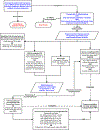Diagnosis and treatment of Clostridium difficile in adults: a systematic review
- PMID: 25626036
- PMCID: PMC6561347
- DOI: 10.1001/jama.2014.17103
Diagnosis and treatment of Clostridium difficile in adults: a systematic review
Abstract
Importance: Since 2000, the incidence and severity of Clostridium difficile infection (CDI) have increased.
Objective: To review current evidence regarding best practices for the diagnosis and treatment of CDI in adults (age ≥ 18 years).
Evidence review: Ovid MEDLINE and Cochrane databases were searched using keywords relevant to the diagnosis and treatment of CDI in adults. Articles published between January 1978 and October 31, 2014, were selected for inclusion based on targeted keyword searches, manual review of bibliographies, and whether the article was a guideline, systematic review, or meta-analysis published within the past 10 years. Of 4682 articles initially identified, 196 were selected for full review. Of these, the most pertinent 116 articles were included. Clinical trials, large observational studies, and more recently published articles were prioritized in the selection process.
Findings: Laboratory testing cannot distinguish between asymptomatic colonization and symptomatic infection with C difficile. Diagnostic approaches are complex due to the availability of multiple testing strategies. Multistep algorithms using polymerase chain reaction (PCR) for the toxin gene(s) or single-step PCR on liquid stool samples have the best test performance characteristics (for multistep: sensitivity was 0.68-1.00 and specificity was 0.92-1.00; and for single step: sensitivity was 0.86-0.92 and specificity was 0.94-0.97). Vancomycin and metronidazole are first-line therapies for most patients, although treatment failures have been associated with metronidazole in severe or complicated cases of CDI. Recent data demonstrate clinical success rates of 66.3% for metronidazole vs 78.5% for vancomycin for severe CDI. Newer therapies show promising results, including fidaxomicin (similar clinical cure rates to vancomycin, with lower recurrence rates for fidaxomicin, 15.4% vs vancomycin, 25.3%; P = .005) and fecal microbiota transplantation (response rates of 83%-94% for recurrent CDI).
Conclusions and relevance: Diagnostic testing for CDI should be performed only in symptomatic patients. Treatment strategies should be based on disease severity, history of prior CDI, and the individual patient's risk of recurrence. Vancomycin is the treatment of choice for severe or complicated CDI, with or without adjunctive therapies. Metronidazole is appropriate for mild disease. Fidaxomicin is a therapeutic option for patients with recurrent CDI or a high risk of recurrence. Fecal microbiota transplantation is associated with symptom resolution of recurrent CDI but its role in primary and severe CDI is not established.
Conflict of interest statement
Conflicts of Interest Disclosures: All authors have completed and submitted the ICJME Form for Disclosure of Potential Conflicts of Interest: None reported. JAMA Associate Editor, Dr Malani had no role in the review of the paper or decision to accept for publication.
Figures


Comment in
-
Treatment for Clostridium difficile infection in adults.JAMA. 2015 May 19;313(19):1974-5. doi: 10.1001/jama.2015.3668. JAMA. 2015. PMID: 25988469 No abstract available.
-
Treatment for Clostridium difficile infection in adults.JAMA. 2015 May 19;313(19):1975-6. doi: 10.1001/jama.2015.3671. JAMA. 2015. PMID: 25988470 No abstract available.
-
Treatment for Clostridium difficile infection in adults--reply.JAMA. 2015 May 19;313(19):1976. doi: 10.1001/jama.2015.3674. JAMA. 2015. PMID: 25988472 No abstract available.
References
-
- Bartlett JG, Chang TW, Gurwith M, Gorbach SL, Onderdonk AB. Antibiotic-associated pseudomembranous colitis due to toxin-producing clostridia. N. Engl. J. Med 1978;298(10):531–534. - PubMed
-
- Vardakas KZ, Polyzos KA, Patouni K, Rafailidis PI, Samonis G, Falagas ME. Treatment failure and recurrence of Clostridium difficile infection following treatment with vancomycin or metronidazole: a systematic review of the evidence. Int. J. Antimicrob. Agents 2012;40(1):1–8. - PubMed
-
- Pepin J, Alary ME, Valiquette L, et al. Increasing risk of relapse after treatment of Clostridium difficile colitis in Quebec, Canada. Clin. Infect. Dis 2005;40(11):1591–1597. - PubMed
-
- Elixhauser A, Jhung M. Clostridium Difficile-Associated Disease in U.S. Hospitals, 1993–2005: Statistical Brief #50. Healthcare Cost and Utilization Project (HCUP) Statistical Briefs Rockville MD: 2006.
Publication types
MeSH terms
Substances
Grants and funding
LinkOut - more resources
Full Text Sources
Other Literature Sources
Medical
Miscellaneous

